Thebes: West Bank and The Valley of the Kings and Queens.
Today it's called Luxor but in Ancient Egypt it was Thebes divided between the east bank and the west bank of the Nile. On the east bank were located the city, the Temple of Karnak and the Temple of Luxor. In ancient times you had to cross the river to the west bank by boat. The west bank is desert and mountains and it was the direction the setting sun took before it journeyed through the Underworld. For the anciet Egyptians, the westward crossing was not so much a journey to the shores of the Dead but more the voyage to the land of Life. The west was the direction the deceasd would go to be admitted to the Day of Judgement by Osiris.
![]()
![]()
Jan 12, 2004
| We left east Thebes and crossed the modern steel bridge to the west. As we rode through the countryside we passed this tranquil scene of a mud brick home next to one of the many canals providing water from the Nile to the farms. | 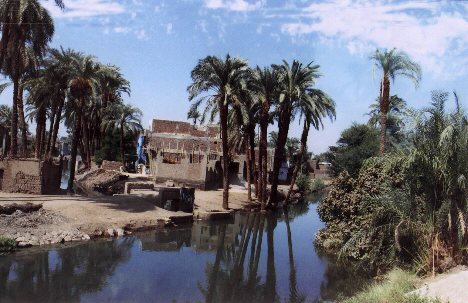 |
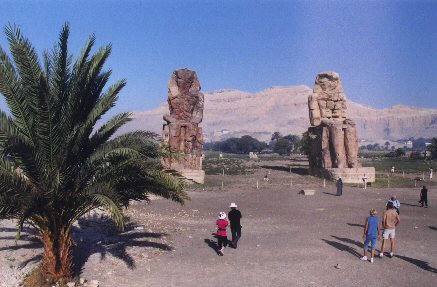
Clearly this stone is not native to this limestone region. Each one is about 6 stories high (18 meters) and weight about 1,300 tons each. The temple fell as a result of an earthquake in 27 B.C. and the Colossi cracked from their shoulders to the hips.
| Since then the two statues began to "sing" when the sun rose in the morning which led to the creation of the "Oracle of Memnon" a Greek mythical king and became a pilgrimage site for the Greeks and Romans. Thus the current name. Roman emperors Hadrian and Septimius Severus make a pilgrimage to the site, and, not willing to leave well enough alone Septimius Severus attempted to find favor with the gods by repairing the statues and they have ceased to sing. Gosh, I would hate to wonder what that means the gods think of the Romans. | 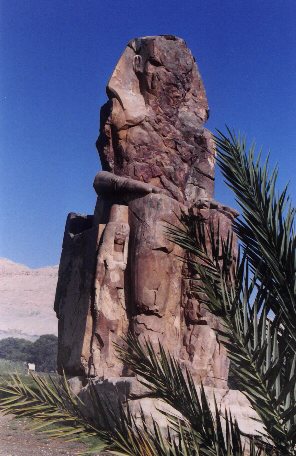 |
Jan 13, 2004
To say it was hot in the Valley of the Queens and Valley of the Kings would be an understatement. It was at least 100 degrees and this was late October. You can imagine what it was like digging these tombs in the middle of the summer. The Valley of the Queens and Valley of the Queens are separated by several miles of desert but other than that they look alike. Not much landscape at all - they just look like old river valleys coming down from the mountains on the west bank of Thebes.
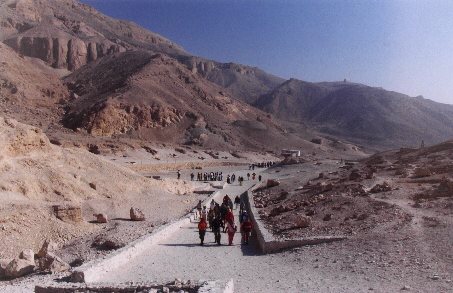
The tombs were dug down into the limestone so you would walk down a long, but not steep nor narrow, tunnel until you entered the tomb itself. The area is hot and the air is dry and that is the reason why the paintings on the walls have lasted all these years. In order to prevent destruction of the paintings the government limits the number of tombs that are open at any one time in order to prevent the humidity from the touriests' bodies from causing destruction. Photographs are also strictly prohibited.
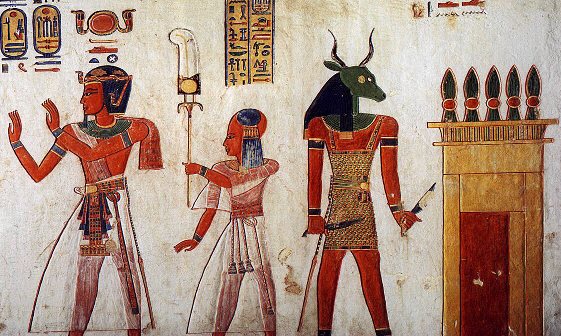
One of the tombs we visited was that of Prince Amenhikhopeshef, a son of Ramses III. You can see the son in the middle with the haircut like the one Yul Brenner wore when he was only a Prince in the movie "Moses". The bald head with a lock on one side was the sign that you were looking at a prince. Here the prince is shown being accompanied by his father, Ramses III, in the offering ceremony and being presented to the gods. To the right is Thoth. The entire tomb was painted with vivid colors of scenes where a loving Pharaoh god is shown walking with his dead son and introducing him to the gods. Of course the Pharaoh could do this because he was also a god. Take a close look at the beard on Ramses. Note it is straight - this tells us that Ramses is still alive when his son died. If the Pharaoh is dead then the beard is depicted as having a small curve at the bottom. Oh, so much to learn and so little time.
you may wonder how anyone knows which Pharaoh is being
depicted. Above is a close up of the painting from the tomb of Amnhikhopeshef, the son of
Ramasse III. Notice in the upper
left hand corner there are two cartouches (elongated circles with a knot at
the bottom). These cartouches spell out the name of Ramasse III. 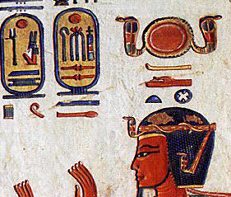 |
One of the ways the code of the ancient hieroglyphics was broken is by looking at the names of known Pharaohs and comparing them to other writings. Another interesting feature of the cartouche is that it gives you a clue as to how any writing is to be read. believe it or not the Egyptians not only wrote from left to right (western European style) but also from right to left (Arabic style) but also top to bottom and bottom to top. But.... the cartouche was always written with the last letter of the name next to the knot. Also, you can look at the direction the characters are facing - they always face in the direction you are to read. |
Jan 14, 2004
After leaving the Valley of the Queens we traveled by bus to the infamous Valley of the Kings. It is hot and it is huge but worth every drop of sweat. Cost of the ticket is 30 L.E. ($5.70) and that allowed us to enter three tombs. How is one suppose to choose? It is a long up hill walk from the entrance (right of photo) to the tombs.
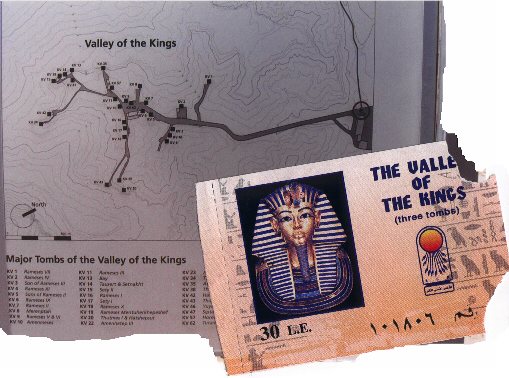
Fortunately the entrance fee includes a ride on a train which you
can ride to the top. Guides are not allowed in the tombs so we stood
outside and listened to a general introduction and then had to pick where
we wanted to go and enter the tombs on our own. Our
program directors gave us their opinion of which of the best tombs to see.
Flash photograph is forbidden and in
some tombs you even had to check your camera at the gate before entering the
tomb. In some places the guide offered to take our picture before we
entered . There are some photographic techniques which I use which help get pictures without a flash.
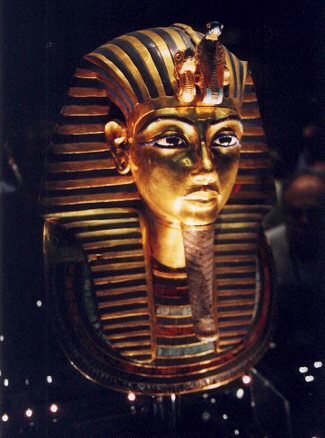
Here is a photo I took in the Cairo Museum without a flash.
| Naturally everyone wants to see the tomb of King Tut, so, there is an extra fee to get into his tomb - 40 L.E. ($7.60). I was surprised that some people didn't care to see the tomb after learning there was an extra fee. It strikes me as strange; they spend $3,000 to get here and then bulk at spending an extra $7.60 to see one of the greatest archeological sites in the entire world. Not me! | 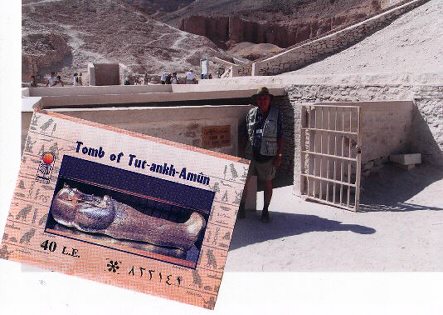 |
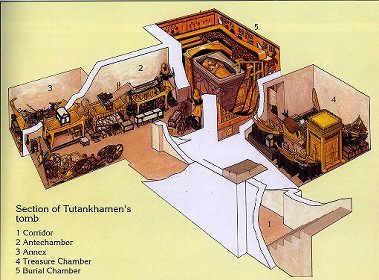
(photo copied from my Art and History of Egypt book)
Everything in rooms 1, 2, 4, and most of three are now in the Egyptian museum in Cairo. We walked down the entrance ramp (1) into the now empty room (2) and then to our right we saw:
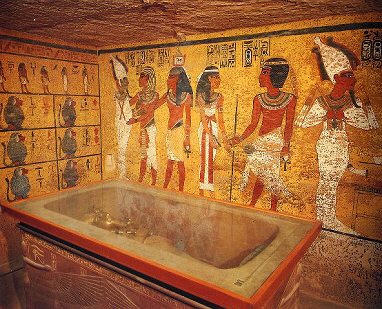
(photo from my Art & History of Egypt book)
BREATHLESS!
This is one of the few tombs were they have left the mummy in the sarcophagus. It even has one of the gold masks covering the mummy as it was found. The mask I showed in an earlier picture was one of three covering King Tut's head. Two are in the Cairo museum and one is still in this tomb. One can only guess at the riches which must have been buried with thee important Pharaohs like Rameses. Their tombs are massive in size with long corridors and many rooms.
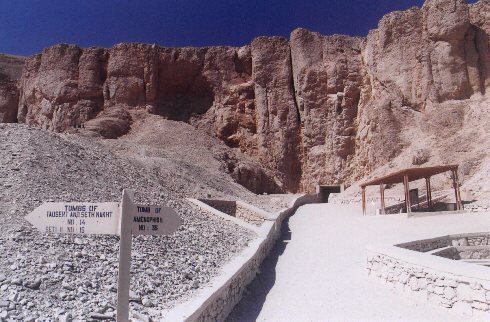 Roads leading to tombs everywhere. You can see one up the road to the left and one at the end of the road, several more are seen to the right. |
After we left King Tut's tomb we then had to decide which of the other three tombs we wanted to see. Lots of choices to make. |
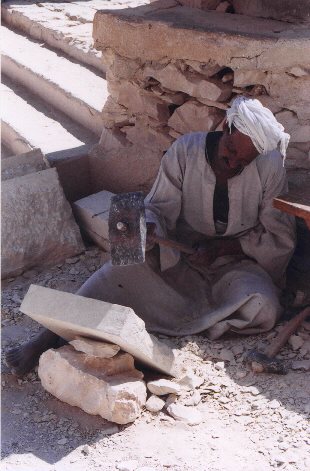 |
As we walked up to one of the tombs we saw two men working limestone with these large hammers. I don't know what they were building but it gives some idea of what it was like to work in the hot sun which limestone dust and chips everywhere. |
Jan 15, 2004
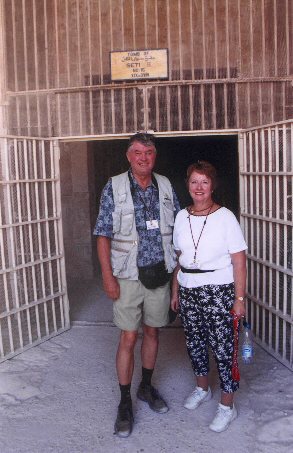 |
One of the next tombs we visited was that of Sety II. The guard at the gate insisted on taking our picture. Iron gates closed at night prevent any modern day tomb robber from getting in. Anyway, I knew that many of you would be interested in seeing what the "well dressed Egyptian traveler" wore into the tombs at the Valley of the Kings. Note the limestone dust on my shoes. Fran is carrying a bottle of water, a real necessity here. |
The pyramids at Giza have no burial sarcophagus and no paintings on the walls. It took all their strength just to lug the huge stones up to such staggering heights. After the third pyramid was finished the focus of Egypt moved south to Thebes and the Pharaohs were buried in the Valley of the Kings. Large tombs chiseled out of solid limestone intended for the Pharaoh's last resting place. By tradition the tomb was not completed until the Pharaoh died and sometimes they were caught off guard because the Pharaoh died suddenly.
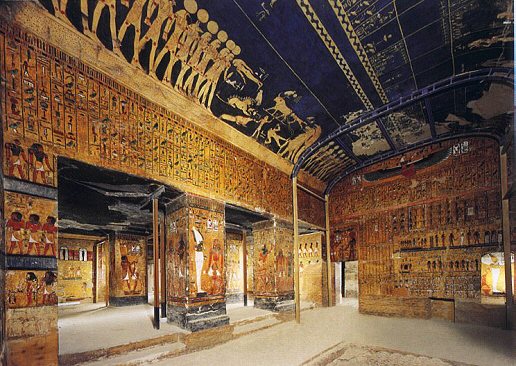
(photo of burial chamber in the tomb of Sety I from Ancient Egypt, Agnese and Re, Barnes & Noble, Inc, 2002)
Usually when you entered the tomb there was a long corridor with scenes of the Pharaoh meeting the various gods and being quizzed as to whether he was kind to widows, did he help the poor, did he take care of his people, was he honest, was he just, etc. I imagine that knowing this kind of interrogation was going to take place after he died helped keep the Pharaoh on the right track during his life. There is the traditional scene of the Pharaoh's heart being weighed and if it weighed too much he didn't go to join Osiris in the heavens.
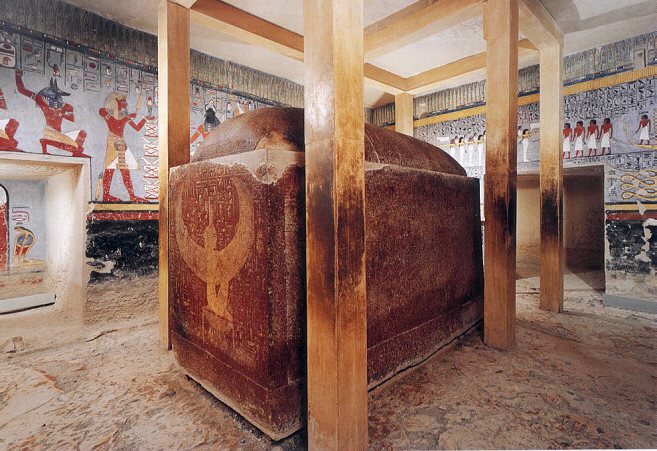
(photo of burial chamber in the tomb of Rameses I with pink granite sarcophagus from Ancient Egypt, Agnese and Re, Barnes & Noble, Inc, 2002)
As you descended into the tomb the corridor may have several side rooms for treasures and offerings to the gods. Finally you would arrive in the burial chamber which was elaborately decorated floor to ceiling. Maybe it is good I was not allowed to take photographs in some of these tombs because I just could not have done them justice.
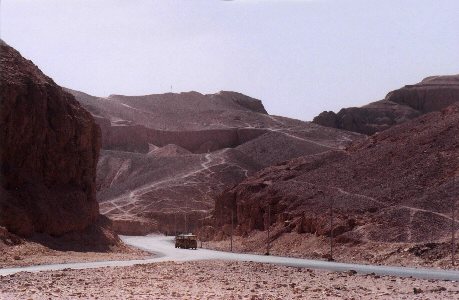
After fighting away the mobs of trinket salesmen, but not before buying some suitable treasures, we boarded the air conditioned bus and headed toward Luxor on the east bank.
Jump Station
Go to The Egyption Museum of Cairo - Under Construcion
Go to The Religious Faiths - Under Construction Go to Street Scenes of Cairo - Under Construction Go to Who are the Gods? - Under Construction. Go to Chapter 9: The Khan el-Khali Bazaar - Under Construction Go to Chapter 8: The Pyramids - Under Construction Go to Chapter 7: East Thebes and the Temple of Luxor - Under Construction Return to Chapter 6: The Pyramids.Return to Chapter 5: Karnak Temple at Luxor and the Temple of Hathor at Dendera.
>Return to Chapter 4: Kom Ombo, Edfu, Karnak and Dendera.
Return to Chapter 3: Cruising Down the Nile.
Return to Chapter 2: Abu Simbel and Aswan.
Return to Chapter 1: Introduction to Egypt.
Read about my version of The Gods of Egypt and Diagram of Temples.
Return to Belli's Home Page
![]()
For more information about our travels write to![]() Belli.
Belli.
